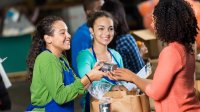3 Ways to Be a Thermostat, Not a Thermometer
Through their actions, students and teachers can help regulate the temperature at their schools, improving the climate for everyone.
Your content has been saved!
Go to My Saved Content.What does it mean to be a thermostat, not a thermometer?
It’s a thought-provoking analogy from Martin Luther King Jr. We can think about it this way: A thermometer simply reports the temperature around it; a thermostat makes a difference—it actively regulates and changes the environment.
Being a thermostat is an empowering mindset, especially in our learning communities where each of us (kids and adults) can contribute to a positive climate and a culture of care.
Prosocial Strengths in Learning Communities
So, where do we start? Empathy, compassion, cooperation, kindness, and gratitude are prosocial emotions and behaviors that promote positive social interactions. These strengths are also foundational for building supportive, collaborative, and inclusive learning spaces.
Here’s a little more about these prosocial strengths as well as their alignment with the CASEL (Collaborative for Academic, Social, and Emotional Learning) 5:
- Empathy allows us to understand and connect with each other, fostering a sense of belonging. (social awareness, relationship skills)
- Compassion extends empathy’s understanding into caring actions, creating a supportive atmosphere. (social awareness, relationship skills, responsible decision-making)
- Cooperation promotes teamwork and inclusivity, crucial for a positive learning experience. (relationship skills, social awareness)
- Kindness brings a layer of warmth to our interactions, encouraging a welcoming and nurturing environment. (social awareness, relationship skills, responsible decision-making, self-management)
- Gratitude is key to flourishing and creates a culture of authentic, healthy positivity. As Cicero said, “Gratitude is not only the greatest of virtues, but the parent of all the others.” (self-awareness, social awareness, relationship skills, responsible decision-making, self-management)
These aren’t just ideals, they are how we build learning communities that improve well-being, nurture relationships, and activate learning.
Embracing Our Role
So, who are we asking to be a thermostat? This is a call to action for ourselves to model regulating and improving the climate. It’s also a message and a mindset we can foster in learners by engineering opportunities and through positive reinforcement.
Before we look at specific ways to impact the climate and create a culture of care, let’s consider how we are all unique and dynamic, making a one-size-fits-all approach insufficient and likely counterproductive. Offering voice and choice is a great way to honor and value everyone’s lived experience.
Consider using invitational language like “I invite you to…” and avoiding directives that imply there’s only one right way to participate. For example, research supports greeting students at the door to enhance belonging and learning readiness. An important aspect of this is flexibility in how individuals are greeted. The teacher in this video came up with lots of options, so learners can choose based on their in-the-moment comfort and preference.
3 Ways to Improve the Climate and Create a Culture of Care
1. Foster a service mindset. We can nurture prosocial emotions and behaviors by encouraging a service mindset. It’s about turning learning experiences into opportunities to collaborate, lead, and make a difference. Here are two examples that enrich learning through practical service, fostering teamwork, altruism, and social responsibility:
Learner-driven design: Design thinking, project-based learning (PBL), challenge-based learning (CBL), and other inquiry-based methods empower learners. Note: For those new to inquiry-based learning, consider starting with the Question Formulation Technique and/or Discover, Discuss, Demonstrate.
Global stewardship: Empower learners to contribute positively on a broader scale. Engaging in international projects and connecting across borders broadens learners’ horizons and instills a sense of global responsibility. This could involve partnering with a school in another country for a joint environmental project or participating in global virtual forums discussing world issues.
One of my favorite examples of learners leading with a service mindset is the inspirED initiative. InspirED’s goal is to empower kids to work together to create a more positive school climate and foster greater well-being in their schools and communities.
2. Inspire intentional acts of kindness. Small acts of kindness can ripple through our learning communities, creating waves of positive change. Here are two actionable examples:
Spreading good vibes challenge: Promote intentional acts of kindness. In Bold Gratitude: The Journal Designed for You and by You, I created this checklist as a playful and powerful way to do this. This checklist embodies the essence of being a thermostat—small actions, big difference.
Peer mentoring: Facilitate peer support for reciprocal learning, promoting empathy and compassion.
3. Notice and value the good in others. Research indicates that gratitude can have an outsized, positive effect on well-being and relationships. In previous articles, I’ve shared ways to bring gratitude into our learning communities:
Here are two simple yet powerful ways to extend gratitude beyond our learning communities:
Hero letters: Invite learners to write to active military or write to a local hero (e.g., a mail carrier, a firefighter, a librarian, school staff, neighbors). Here are some sentence stems that can help.
Positive online reviews: Encourage learners to share positive online reviews for local businesses, a gesture that celebrates successes and strengthens community ties.
Let’s commit ourselves and inspire others to be a thermostat, not just a thermometer. Whether it’s through service, spreading kindness, or valuing the good in others, these are small yet profound steps toward a more caring and inclusive world.
